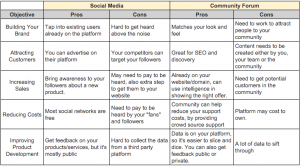— June 12, 2019
You need more than just a budget in place before starting paid social advertising—that is, if you want your paid social campaign tests to have the best structure in place for success. Whatever platform or platforms you’re planning on allocating spend to, set yourself up for success by having these things in place before spending your first dollar.
1. Goals and Objectives
This should be obvious, but don’t plan your campaigns in a vacuum. Determine how the paid social platforms you’re using and the campaigns you plan to run fit into the organization’s short- and long-term goals.
It’s okay to not know exactly what to expect when testing a new platform or campaign or type of ad, but having high-level company goals to compare results to is a must.
2. Clearly Defined Buyer Personas for Each Platform
Has it been a couple of years since your team created your buyer personas? Now might be a good time to revisit your primary personas. Over time, you learn more about your personas and should update them based on what you’re learning. This is especially true when it comes to paid media, because you will always refer to your buyer personas when building audiences.
Negative buyer personas will help you determine who you don’t want to target with your ads. In some cases, it might make sense to exclude these users from the audiences you create.
3. Content that Your Buyer Personas Actually Want
It can be tempting to start doing paid social before you have an optimized landing page or site page to drive targeted traffic to. If you’re a startup and don’t have any data regarding which of your site pages or landing pages convert best, simply following best practices when designing or updating landing pages for your paid media campaigns can go a long way.
Already have a guide or other valuable piece of content for your primary buyer personas? Or have you been putting off creating one? Now would be a great time to get that ready to use with your paid campaigns. If you’re initially trying to prove that paid social is a viable channel for your organization, it’s an especially good strategy to have a valuable content asset in place to build paid social campaigns around. Be sure to tailor the content, landing page, and follow-up workflow to the specific buyer persona you’re targeting with the ads.
4. Optimized Landing Pages and Thank You Pages
We can’t stress this enough: It doesn’t matter how much-qualified traffic you send to a landing page if no one is converting on it. Before you spend ad dollars, audit your site—with special attention to your landing and thank you pages—and make any necessary improvements. Use heat mapping software to analyze visitor behavior and make informed decisions around page optimization.
Most importantly, tailor landing pages to the persona you’ll be targeting with your ad campaigns. This might include duplicating a landing page for each primary persona so that the copy and images speak directly to them. Your ad creative, landing page, and any follow-up should all be tailored to the persona you’re targeting with the campaign.
5. Follow-Up Workflows for Lead Nurturing
As part of your campaign strategy, determine what content you want these new leads to see as a follow-up. First step: Make sure that, if they’re downloading a content offer, they receive a thank you email with a direct link to the asset. Then, think about the typical path to purchase (or whatever the end goal is for this persona) and tailor the follow-up workflow accordingly.
For bottom of the funnel campaigns such as “request a consultation,” you should use automated follow-up workflows to notify the proper team member so that they can respond in a timely manner.
6. The Proper Permissions and Access
Determine who at your organization needs access and what level of permissions they need in the account(s). Also, if you have an agency or outside partner who needs access, set them up with what they will need as well.
Make sure that more than one employee has administrative access to the relevant assets. This will lessen the risk of losing your company’s ad account and/or pages in the event that an employee leaves the company, loses their access, or is out of the office when you need to make changes.
Hopefully, these actions items help you set yourself up for success and avoid some of the common mistakes with paid social advertising.
Digital & Social Articles on Business 2 Community
(31)
Report Post





